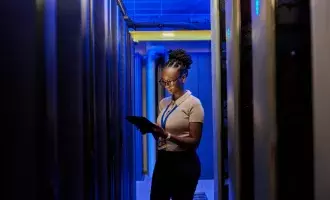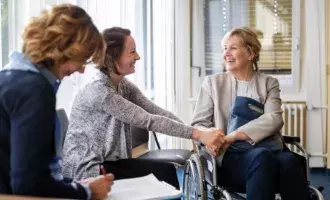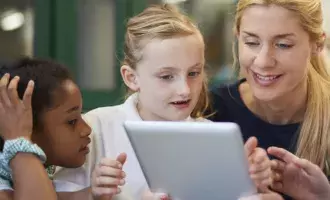Life can change when you least expect it, and sometimes in very radical ways. That’s been my experience over the last couple of years. Out on a local cycle ride in June 2019 I was involved in a road traffic accident that left me critically injured. I suffered life-changing spinal injuries as result.
The good news is that I am continuing to make a very strong recovery. Perhaps inevitably, I’ve developed a great interest in the disability agenda and now back in a senior leadership position at Capita I chair our disability employee network group, the Capita Ability Network (CAN). The success of CAN is down to a number of factors, and we’ve benefitted greatly from the assistance of PurpleSpace and its CEO and Creator, Kate Nash. PurpleSpace is the world’s only networking and professional development hub for disabled employees.
A few weeks ago, Kate and I got together for a socially-distanced conversation to explore the subject further: the best way to inculcate an inclusive and respectful workplace, the effects of the pandemic, and applying workplace learning to frontline delivery were among the discussion points. What follows are the key takeaways from that conversation.
1. Storytelling is a potent means of sharing lived experiences
“We know sometimes our stories of disability are seemingly very different,” Kate told me during our conversation. “But if you scratch the surface there is so much we share.” Narrative story telling is a powerful way to expose lived experiences not only between groups with very different disabilities, but also to non-disabled colleagues, too. It helps combat what Kate describes as “the soft bigotry of low expectations”. The stories told might be “glossy and shiny” featuring video campaigns and newsletters but they can equally take a “gentler” approach, a team meeting, for example. As Kate told me: “If you don’t have a lived experience, you don’t always know what you can do as a non-disabled person.”
2. The power of allies will overcome ‘clumsy’ language
As with storytelling, a workplace allies programme aims to build relationships based on trust, understanding and empathy by bringing disabled and non-disabled groups together. Empathy is the key word and it cuts both ways. Certainly, non-disabled employees should be respectful of the needs of their disabled colleagues. Equally, as disabled members of the workforce, we should not shoot them down if they inadvertently use clumsy language. We need to allow for the fact that those attempting to do the right thing may express it in the wrong way, and educate them respectfully. “Remember a disability looks and feels different for everyone, so acknowledge good intent,” said Kate
3. ‘Networkology’ is the most useful term you’ve never heard of
“Networkology is the art and science of delivering real conversations about what it means to be different,” Kate explained during our conversation. And she should know, having coined the term. The science is about ensuring the structures and governance are in place to allow for a high-performing network that provide the conditions for interactions that normalise disability. The art of networkology is finding ways to move beyond individual circles of influence so diversity and inclusion isn’t just the preserve of the HR department, but becomes rooted in the life of the whole organisation. “It requires us to think deeply and innovatively,” added Kate.
4. The two reasons why disability is trailing behind in the diversity and inclusion agenda
As Kate noted, there are many examples of ally programmes “very skilfully” serving BAME, LGBT+, and gender-based communities. There are fewer serving those with disabilities. Why? For two reasons. First, disability is often a transitional experience. Of all disabled people around the world, Kate told me, 83-86%, like me, will have acquired their disability during the course of their working lives. “There are very few aspects of human difference that so starkly result in this kind of step change.” As a result, not everyone is “out, loud and proud” which in turn means organisations often underestimate the number of disabled people they employ. In reality, one in ten people will have a disability in most companies. Second, because disability is such a broad church of physical and mental conditions, bringing this disparate cohort together can prove difficult.
5. The pandemic can pave the way for a blended working life, if we ask the right questions
One of the consequences of efforts to limit the spread of Covid-19 over the last 15 months has been the dislocation of work from the traditional workplace. As we contemplate a return to normality, the challenge is to build a blended working life. “As we live and work in this supercharged digital era, how can we use its best features to deliver more elegantly, efficiently and cost effectively?” asked Kate.
6. Apply workplace insights to frontline delivery
The Capita Ability Network is still relatively new, and we have much to learn. Kate urged us to put emerging knowledge to good use, pressing Capita to “plough that learning back into frontline delivery”. She had some kind words about our intentions so far: “I’m enjoying your desire to deliver better as a company through learning directly from your own people.” Practically speaking, that means moving beyond thinking about disability just in the context of doctors, governments, and welfare reform. It is also about supporting people to feel good about themselves and to know that their talent and economic contribution is valuable and necessary.”

Damian Riley
Damian Riley is Client Partner and Managing Director for Education Services at Capita, having previously held senior leadership positions including MD of our PIP service, and COO of Capita Transformation. Damian has a 20-year background in delivering complex transformation programmes across government, much of this gained as a Consulting Director at PwC. He is a published author and a passionate advocate for mental health awareness, workplace diversity, and a spinal cord injury survivor.







